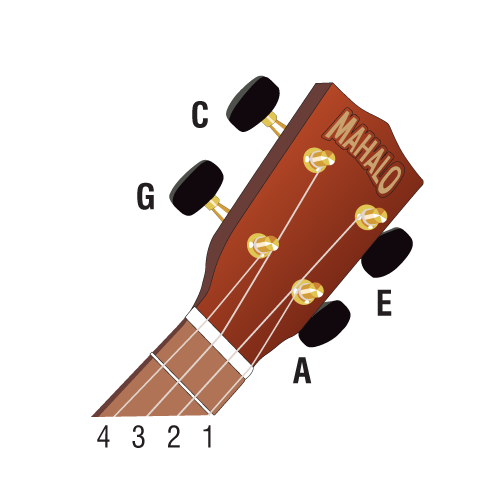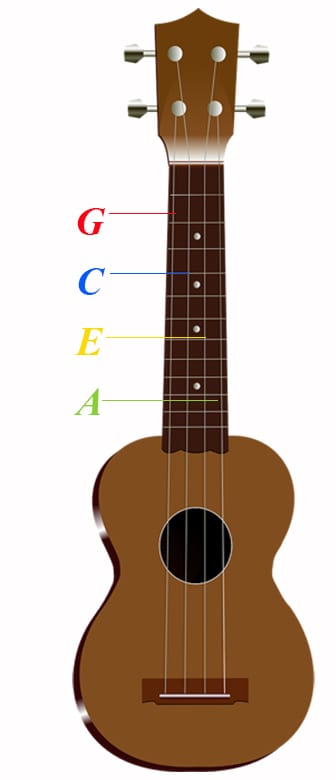The standard tuning for a ukulele is G-C-E-A. This configuration is also known as “C tuning” and is widely used by ukulele players.
The ukulele, a small, four-stringed instrument originally from Hawaii, has charmed musicians worldwide with its delightful sound and portable size. Its tuning, G-C-E-A, often represents the notes of a soprano, concert, and tenor ukulele. While alternative tunings exist, this standard arrangement allows for a wide range of melodic possibility and harmonic versatility.
Playing the ukulele can be an enjoyable experience for beginners and seasoned musicians alike, encouraged by the accessible learning curve and the instrument’s bright, cheerful tone. Whether strummed or plucked, the ukulele’s standard tuning lays the foundation for a rich repertoire of songs throughout various genres.
Traditional Ukulele Tuning
The magic of ukulele music often begins with its distinctive tuning, known as Traditional Ukulele Tuning. It’s what sets the ukulele apart, creating a sound that instantly transports the listener to tropical islands and sunny beaches. Let’s delve into the notes that bring a ukulele to life.
Four String Harmony
The ukulele traditionally has four strings. Each string produces a unique note. Together, these notes create a harmonious blend. The traditional tuning involves setting specific pitches to each string. This tuning helps to achieve that classic, cheerful ukulele sound. Tuning these strings just right is crucial to playing songs that resonate with the instrument’s iconic tone.
Tuning To Standard Notes: Gcea
The standard notes for a ukulele are G, C, E, and A. We tune the strings from top to bottom. This is how each string corresponds to a note:
- G: The fourth string, closest to your face when holding the ukulele upright
- C: The third string
- E: The second string
- A: The first string, closest to your toes when playing
This GCEA tuning is also referred to as “C tuning” and it’s the most popular for sopranos, concerts, and tenors—the common types of ukuleles. Keep in mind, the ‘G’ is tuned higher than the ‘C’, which is what gives the ukulele its distinctive jangle.
Correct tuning ensures each chord rings true and each melody sparkles. The harmonious relationship between the strings brings out the authentic sound of the ukulele.
Alternate Tuning Options
Alternate Tuning Options add a new dimension to playing the ukulele. These tunings provide different sounds and can be very fun to explore. Let’s look at some popular alternate tunings that might spark your creativity.
Baritone Tuning: Dgbe
Baritone Tuning (DGBE) changes the pitch of your ukulele significantly, as it matches the bottom four strings of a guitar. This lower tuning creates a deep and full sound. Here’s what each string corresponds to:
- Fourth String (D): Same as the fourth string on a guitar
- Third String (G): Same as the third string on a guitar
- Second String (B): Same as the second string on a guitar
- First String (E): Same as the first string on a guitar
Slack-key Tuning Variations
Slack-Key Tuning is a Hawaiian favorite that slackens or lowers the pitches of the strings. This creates a unique, open sound. Common variations include:
| Tuning | Fourth String | Third String | Second String | First String |
|---|---|---|---|---|
| GCEG (Taro Patch) | G | C | E | G |
| DGDG (Wahine) | D | G | D | G |
Try different slack-key tunings to find the one that resonates with you.
Tools For Tuning
Strumming your ukulele, you expect it to produce sweet, harmonic sounds. But before that can happen, it needs proper tuning. With the right tools, tuning your ukulele becomes a breeze, whether you’re a beginner or a seasoned musician. Explore these essential tools designed to ensure your ukulele sounds just right.
Electronic Tuners
Electronic tuners are a popular choice among ukulele players. Attach these devices directly to your instrument to read the vibrations. They offer a clear visual indication when each string reaches the correct pitch. Here’s why they stand out:
- Accuracy: They provide precise tuning, even in noisy environments.
- Convenience: Easy to use with a simple clip-on mechanism.
- Visibility: Many come with backlit displays for dark settings.
Tuning Apps
In today’s digital age, tuning apps are handy for quick tuning. Download one of the many tuning apps available for smartphones and tablets. These apps detect the pitch through your device’s microphone. Features of tuning apps include:
- Portability: Carry your tuner in your pocket with your phone.
- Cost-effectiveness: Many apps are free or low-cost.
- Functionality: Additional features such as metronomes are often included.
Pitch Pipes And Tuning Forks
Pitch pipes and tuning forks offer traditional tuning methods. These analog tools don’t require batteries or electricity. Here’s what makes them special:
- Pitch Pipes:
- Blow into these small, harmonica-like instruments to hear the target pitch for each string.
- Tuning Forks:
- Strike them and hold to your ukulele’s body to match the pitch acoustically.
Choose the right tuning tool that best fits your style and environment, and enjoy the perfect harmony of your ukulele.

Credit: mahaloukuleles.com
Tuning By Ear
Tuning a ukulele by ear is an important skill. It helps train your ears to recognize the correct pitches. With practice, you’ll tune your instrument without needing electronic tools. This section helps you master the art of tuning your ukulele by ear.
Listening For The Pitch
Active listening is key when tuning your ukulele. Start by plucking the top G-string. Listen closely to its pitch. You want to match the other strings to this sound. Compare the tones of the strings as you adjust them. If a string sounds too high or too low, adjust the tuning pegs gently.
Use a tuning fork, piano, or another ukulele as your reference. Match their pitches with your ukulele by ear. This practice improves your pitch recognition over time.
Finding The Right Octave
It’s important to tune your ukulele in the correct octave. A note too high or too low won’t harmonize properly. This can make your ukulele sound off.
Listen for the warmth in the tone to find the right octave. The standard tuning of G, C, E, A should sound bright and resonate clearly. If the note sounds thin, it might be an octave too high. If it’s too boomy, it’s likely an octave too low.
Start with the C-string, the second thickest string, which is an octave higher than middle C on a piano. Ensure the G-string, your top string, tunes to just the right pitch, neither too sharp nor too flat.
Maintaining Tuning Stability
Maintaining Tuning Stability for a ukulele can be challenging. Ukuleles often go out of tune. This can be frustrating for players. Keeping your ukulele in tune is important. It ensures the best sound. This post will cover three key factors. They affect tuning stability. Let’s dive deeper into each one.
String Quality And Age
High-quality strings are crucial. They hold tuning better than cheaper ones. Over time, strings can wear out. This affects sound and tuning. Change strings when:
- You notice discoloration or wear.
- The sound becomes dull.
- Tuning gets more difficult.
New strings may stretch. Re-tuning more often is necessary. Once settled, tuning becomes more stable.
Environmental Factors
Your ukulele responds to the environment. Temperature and humidity are important. Extreme changes cause wood to expand or contract. This leads to tuning problems. Keep your ukulele in a stable environment. Use a humidifier in dry areas. Avoid leaving your instrument in the sun. Care for it and it will stay in tune better.
Proper String Winding Techniques
How you wind strings on tuning pegs affects stability. It’s essential to wind strings correctly. Ensure you:
- Wind from top to bottom.
- Leave no slack.
- Wind evenly.
Proper winding prevents slippage. This keeps your ukulele in tune longer.

Credit: takelessons.com

Credit: www.youtube.com
Can a Ukulele Be Tuned to Dgbe, and What is the Standard Tuning for a Ukulele?
Yes, a ukulele can be tuned to DGBe, especially if you’re experimenting with different sounds. While the standard tuning for a ukulele is GCEA, many players enjoy tuning a tenor ukulele to dgbe for a richer, deeper tone that opens up new musical possibilities.
Frequently Asked Questions For What Is The Tuning For A Ukulele
What Notes Are The 4 Strings On A Ukulele?
The four strings on a ukulele are typically tuned to G, C, E, and A. This standard tuning allows for versatile play across various genres.
What Is Standard Ukulele Tuning?
Standard ukulele tuning for soprano, concert, and tenor ukuleles is G4-C4-E4-A4. The baritone ukulele typically tunes to D3-G3-B3-E4.
Why Is The Ukulele Tuned Gcea?
The ukulele is tuned GCEA to facilitate easy playability and produce a pleasing, traditional Hawaiian sound. This tuning suits the ukulele’s size and string tension well.
How Do You Manually Tune A Ukulele?
Start by turning on your digital tuner. Ensure the ukulele is in the standard GCEA tuning. Pluck each string individually, beginning with G, and adjust the tuning pegs until the tuner indicates the correct note. Repeat the process for C, E, and A strings.
Conclusion
Mastering the standard G-C-E-A tuning unlocks the delightful potential of the ukulele. By fine-tuning each string, enthusiasts join a global community of musicians. Whether playing soulful solos or cheerful chords, your ukulele’s correct tuning ensures a rich, harmonious experience. Embrace this simple yet pivotal step, and let your music resonate.
